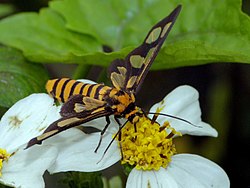| Tiger-striped clearwing moth | |
|---|---|
 | |
| Scientific classification | |
| Kingdom: | Animalia |
| Phylum: | Arthropoda |
| Class: | Insecta |
| Order: | Lepidoptera |
| Superfamily: | Noctuoidea |
| Family: | Erebidae |
| Subfamily: | Arctiinae |
| Genus: | Amata |
| Species: | A. polymita |
| Binomial name | |
| Amata polymita (Linnaeus, 1768) | |
| Synonyms | |
| |
Amata polymita, the tiger-striped clearwing moth, is a moth of the family Erebidae. The species was first described by Carl Linnaeus in 1768. It is found in China and Vietnam. [1]
The wingspan is about 35 mm.
The larvae feed on Breynia fruticosa and Gyaura crepidioidea .